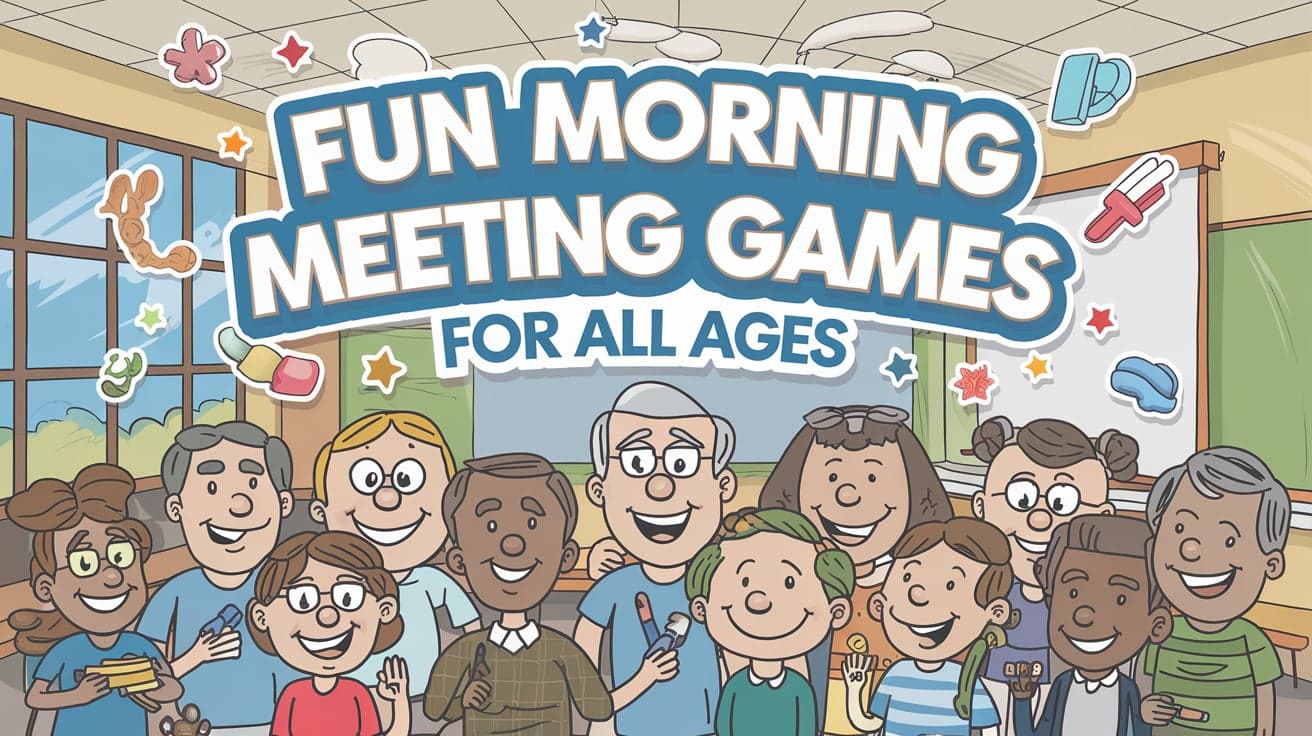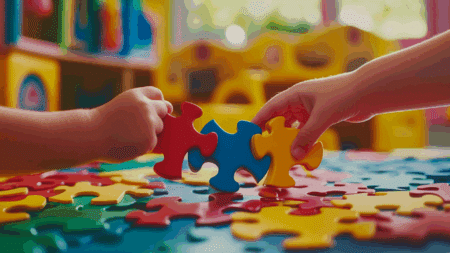What if you could make mornings fun and exciting? Let’s talk about morning meeting games – the trick to waking up happy and ready to go!
Morning meetings are special times that help people start their day right. Imagine walking into a room where everyone is smiling and ready to go through the day together. That’s the power of a well-planned morning meeting game.
In this blog, we’ll explain why morning meetings matter and share fun games for everyone – from little kids to grown-ups at work.
Get ready to learn how to make mornings something everyone looks forward to!
Why Morning Meeting Games Matter?
Morning meeting games help change regular check-ins into more interactive moments. They turn standard meetings into times when people can talk, share, and work together more easily. These games give people a chance to connect and communicate differently.
In classrooms, games like “Two Truths and a Fib” or “Feelings Check-In” help students build trust and develop communication skills. These games encourage children to speak confidently, listen carefully, and respect their classmates.
Simple games teach essential skills like making eye contact, taking turns, and expressing thoughts clearly. Teachers use these interactive moments to understand students’ emotions, discuss potential challenges, and promote a positive learning environment.
In professional settings, morning meeting games serve the equally important purposes of aligning team goals, improving communication, and boosting morale. Activities such as “Quick Team Trivia” or “30-Second Story” help colleagues break communication barriers and work more collaboratively.
These games put energy into workplace interactions, helping teams develop a transparent, supportive culture.
Morning meeting games are short activities that help people start their day together. These games make talking and listening more fun. They help people feel comfortable and get to know each other better. Instead of just sitting quietly, everyone can play a quick game that makes them smile and feel ready to work.
Morning Meeting Games for Different Age Groups
These morning meeting games are great for different age groups and help build friendships, boost focus, and create a fun classroom vibe from the very beginning.
Kindergarten Games

1. Shake It Out
Shake It Out is a super fun morning meeting game that helps kids burn off extra energy and prepare for the day.
In this game, children stand up and start shaking their whole body – arms, legs, fingers, and toes. It’s like a big, silly dance where everyone moves and wiggles around.
Kids love this game because it lets them be silly, move their bodies, and release any nervous or sleepy feelings. By shaking out all the “sillies,” children feel more awake, happy, and ready to learn.
It’s a simple way to help kids feel loose, excited, and prepared for whatever comes next in their day.
2. Simon Says
In this game, one person gives instructions that players must follow, but only when the phrase “Simon says” comes before the command.
For example, if someone says, “Simon says touch your nose,” everyone should touch their nose. But if they just say, “Touch your toes” without “Simon says,” and someone follows the instruction, that player is out and sits down.
This game makes kids pay close attention to every word. It helps children learn to listen carefully, follow directions, and think quickly. Kids love the excitement of trying to stay in the game and avoid being tricked.
Simon Says is a playful way for kids to wake up their brains, improve their concentration, and start the day with lots of laughter and fun.
3. The Color Game
The Color Game is a lively morning meeting activity that gets kids moving while they learn about colors.
In this game, someone calls out a color, and everyone has to quickly find and point to something in the room that matches that color.
The game moves fast, and the colors change quickly to keep things exciting and fun. Kids love running around, searching for specific colored decorations. It’s a great way to help children learn their colors, pay attention, and move their bodies.
The quick pace and fun challenge make kids laugh, stay alert, and start their day with energy and excitement. This game helps children practice observation skills, learn color names, and enjoy a playful start to their morning.
4. Animal Movements
In this game, children are asked to move like different animals – hopping like a frog, slithering like a snake, or flapping like a bird. Each animal movement brings a new challenge and lots of giggles.
Kids love pretending to be different creatures, stretching their bodies in funny ways, and letting their creativity shine.
This game helps children develop their gross motor skills as they jump, crawl, and wiggle around the room.
It’s a great way to wake up their bodies and brains, helping them shake off sleepiness and get ready for the day. The game encourages children to be silly, move freely, and have fun while learning about different animal movements.
5. I Spy with My Little Eye
In this game, one person chooses an object in the room and says, “I spy with my little eye something that is blue.”
Then, all the other children take turns trying to guess what the object might be. Kids love the excitement of looking around the room, using clues to figure out the mystery object.
This game helps children pay close attention to their surroundings, practice their color knowledge, and take turns talking.
It’s a fun way to wake up their brains and get them excited about noticing the details around them.
6. Shake and Tell
Shake and Tell is a playful game that turns guessing into an adventure for kids. The game starts with a small bag filled with different objects, such as toys or blocks.
Children take turns shaking the bag and trying to guess what’s inside just by listening to the sounds. The mystery and surprise make this game super exciting!
When someone finally pulls out the object, everyone gets to see if their guess was right. This game helps kids use their listening skills and learn to describe things they can’t see.
It encourages sensory exploration and helps children develop their language skills by talking about the sounds and possible objects.
7. Musical Chairs
Musical Chairs is a classic game that brings excitement and movement to morning meetings. The game works like this: music plays, and children walk around a circle of chairs.
When the music suddenly stops, everyone must quickly find a seat. One chair is removed each round, making the game more challenging and fun.
Kids love the mix of listening, moving, and the playful competition of finding a chair.
This game helps children practice listening skills, learn to follow instructions, and stay physically active. It’s a great way to release energy, have fun, and start the day with laughter and excitement.
Elementary School Games

8. Name That Sound
Name That Sound is an exciting listening game that turns everyday noises into a fun puzzle.
In this game, someone plays different sounds, such as animal noises, musical instruments, or household items, and the children try to guess what they are.
Kids lean in close, concentrate hard, and get super excited when they recognize a sound. This game helps children develop their listening skills, learn to pay attention to details, and use their imagination.
It’s a playful way to wake up their ears and brains, turning sound into an exciting guessing game that sparks curiosity and wonder.
9. Charades
Charades is a hilarious morning meeting game that gets kids moving and thinking creatively. One child acts out an action without speaking, while the rest of the class tries to guess what they’re doing.
It might involve brushing their teeth, swimming, or pretending to be an animal. Kids love jumping around, making silly movements, and trying to communicate without words.
This game helps children use their imagination, practice body language, and learn to express themselves in fun and creative ways. It’s a great way to start the day with laughter and energy.
10. Would You Rather?
Would You Rather? is a playful game that gets kids thinking and talking about fun and silly choices.
The game leader asks questions like, “Would you rather be able to fly or breathe underwater?” Children get excited about picking their preference and explaining why they made that choice.
This game helps kids practice critical thinking, learn to share their opinions, and listen to their classmates’ different ideas.
It’s a way to encourage conversation, spark imagination, and start the day with interesting discussions that make everyone smile.
11. Quick Draw
Quick Draw is an artistic morning meeting game that gets children’s creativity flowing fast.
The game leader assigns a category, such as animals, food, or objects, and then challenges kids to draw something related to that topic in one minute.
When time is up, everyone shares their drawings and talks about what they created. This game helps children think quickly, use their imagination, and express themselves through art.
It’s a fun way to wake up their creative brains, make everyone laugh, and start the day with a burst of artistic energy.
12. Pass the Clap
Pass the Clap is a fun group game that helps kids work together and stay focused.
In this game, students sit in a circle, and one person starts by clapping once. Then, the clap gets passed around the circle, with each person adding their own twist.
Some might clap once, while others might add more claps to make the pattern more exciting. Everyone has to pay close attention and follow the pattern carefully.
This game helps children learn to work as a team, listen carefully, and stay connected with each other. It’s a great way to start the day by creating a sense of group unity and having fun together.
13. Word Scramble
Word Scramble is a playful game that turns spelling into an exciting challenge.
The game leader writes a word on the board, but with its letters all mixed up. For example, “ctia” becomes the word “cat” that students need to unscramble.
Kids love racing to be the first to figure out the correct word. This game helps children practice their spelling skills, think quickly, and learn new words.
It wakes up their brains and gets them excited about language and problem-solving. Word Scramble is a fun way to start the day with a bit of mental exercise and lots of laughter.
14. Alphabet Story
Alphabet Story is a creative morning meeting game that turns storytelling into a fun group adventure.
The game starts with one student creating a sentence that begins with the letter “A”. For example, “An apple fell from the tree.” Then the next student continues the story with a sentence starting with “B”, like “Bears nearby quickly grabbed the apple.”
Each student takes a turn, adding a sentence that begins with the next letter of the alphabet. By the time the group reaches “Z”, they’ll have created a wild, silly, and unique story together.
This game helps children practice letter recognition, creativity, and listening skills. Kids learn to think quickly, use their imagination, and build on each other’s ideas. The unpredictable part of the story makes everyone eager to hear what comes next, turning learning into a playful and memorable experience.
Middle and High School Games

15. Debate Challenge
Debate Challenge turns the morning meeting into an exciting arena of ideas and persuasion. The class is split into two teams and given a topic to discuss.
It could be something fun like “Should homework be banned?” or a current event that interests students. Teams get a few minutes to prepare their arguments, then take turns presenting their points.
This game does more than just talk – it helps students learn how to think critically, speak confidently, and work together as a team.
Kids learn to listen to different viewpoints, build strong arguments, and respect others’ opinions, even when they disagree.
16. Brain Teasers
Brain Teasers is a game that wakes up minds and gets students thinking creatively from the moment they arrive.
The game involves presenting a series of puzzles, riddles, and tricky questions that challenge students to think outside the box.
Students can work together or compete to solve these mental challenges. Some brain teasers might involve math problems, word puzzles, or logic challenges that require careful thinking and creative problem-solving.
This game helps sharpen mental skills, encourages teamwork, and starts the day with excitement and mental energy.
17. Would You Rather: Ethics Edition
This advanced version of Would You Rather takes the game to a deeper level of thinking.
Instead of silly questions, students are presented with complex ethical dilemmas that make them think carefully about right and wrong.
For example, “Would you rather save the life of one person you love or five strangers?” These questions don’t have easy answers. They push students to explain their reasoning, listen to different perspectives, and understand that moral choices are complicated.
This game helps develop empathy, critical thinking, and the ability to see complex issues from multiple angles.
18. The Silent Challenge
The Silent Challenge is a unique game that tests communication in a completely new way.
Students are given a task – like organizing a list of items or creating a short presentation. But with one big rule: they must do it without speaking.
This forces students to be incredibly creative in their communication. They might collaborate using gestures, facial expressions, or written notes.
The game helps students understand that communication goes far beyond words and teaches them to think flexibly and work as a team under unusual constraints.
19. Word Association
Word Association: Advanced takes a simple game and turns it into a mind-bending challenge of language and creativity.
The game starts with one word, and each student must respond with a word related to the previous one – but the connection can’t be obvious or simple.
If someone says “tree,” the next person might say “forest,” then “ecosystem,” then “balance,” and so on.
This game requires students to think deeply about language, make unexpected connections, and use their imagination in creative ways.
20. Moral Dilemma Scenarios
Moral Dilemma Scenarios invite students to explore complex ethical situations and understand different perspectives.
The game presents a challenging scenario, like finding a wallet with $100 and no ID, and asks students to explain what they would do and why.
Each student takes a turn sharing their reasoning, listening to others, and understanding that moral choices are rarely black and white.
This game helps develop empathy, critical thinking, and the ability to see situations from multiple points of view.
How to Choose the Right Morning Meeting Game
Choosing the right morning meeting game depends on the group’s age, mood, and energy level. Younger children may need games that include movement, while older students might enjoy games that involve thinking or talking.
It’s also helpful to notice how your group feels at the start of the day. If they’re calm or tired, use slower-paced games. If they’re full of energy, pick something more active.
Some games are better for small groups, while others work well with the whole class or team. Make sure everyone has a chance to take part and feel included. If someone is shy or unsure, start with simple, low-pressure games before moving to more interactive ones.
A well-chosen game can make the whole group feel more connected and ready to learn.
Conclusion
Morning meeting games and activities are important because they help set a positive tone for the day.
They make people feel excited and ready to work. Fun games can improve focus, build teamwork, and create a friendly environment.
Try different games to keep things fresh and interesting. Don’t be afraid to experiment with new ideas that fit your group. These activities help students feel more connected and ready for the day ahead.
We push you to give these games a try in your morning meetings and watch how they improve your group dynamic!
For more fun ideas and tips, be sure to follow our other blogs!




